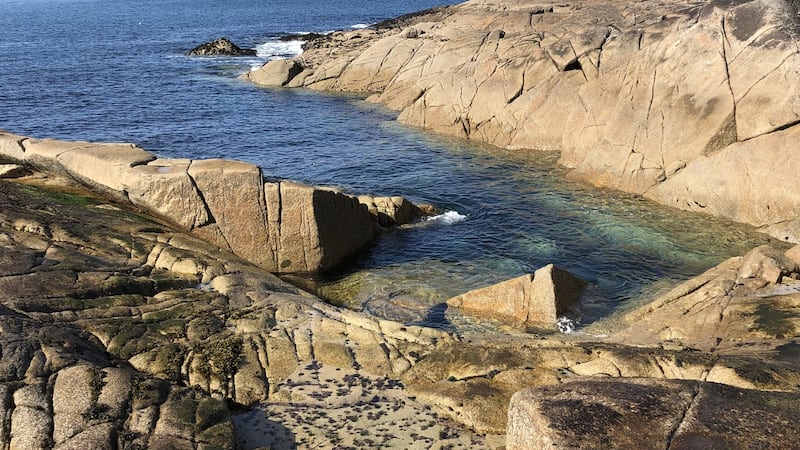The Ice Age left south Connemara in an awful mess. Great untidy dumps of sediment, erratic boulders and hollows littered a chaotic and colourless landscape. Rains came and turned hollow and depression into lake and pond and sent rivers and streams spilling and cascading out to a distant sea.
Global warming , meanwhile, sent great surges of meltwater into the Atlantic, energising and unsettling its climate. The risen ocean assailed the land and thrust deeply into the topography of Connemara, flooding great valleys and plains, turning hills into islands and eventually creating storm beaches, tombolos and cliffs.
In time, sea levels and river courses essentially stabilized, grasses and trees clothed and coloured the grey glacial deposits and animals and people came – all this together created the great physical beauty and human story of Connemara – and the unique charm of Omey Island.

Encouraged by the wealth of the “nice 'n' easy walking” advice in the ever-welcoming Buttermilk Lodge Guesthouse in Clifden, I joined a small throng near Claddaghduff in the car park directly opposite Omey. Under a cloudless April sky we impatiently watched the ebbing tide transform 0.75km of milky blue sea into an expanse of ribbed and puddled sand and strings of prone black seaweed. And then, about three hours before low tide, we all processed across and onto Omey, soon to be lost in its wonderland of dunes and shores and loughs and poignant signs of the island’s longevity as a home for our ancestors.
I walked inland along its one “main” track, wall-bound for about 1.5km, and emerged onto the vast unfenced machair of the island’s southwest corner. This is a place to roam free and wild over green and grassy machair and pink granite pavements, both contrasting beautifully with the blues of sea and sky for me that day. Great perched boulders litter the foreshore there, attesting to the power of millennia of Atlantic storms and unrecorded tsunamis. Take a moment to hang out, lie back on the machair and just listen to high unseen larks and the sound of the sea, or journey onwards, admiring shapely Cruach Island immediately out to the west as you go.

On the day, I wandered the beautiful sunlit shore all the way around the island, past lovely Trá Rabhach, prehistoric middens, St Feichin’s Holy Well and ancient and modern burial site and on back to the car park across the now dry sand. On the north shore, some small human bones in the wet sand recalled a 1990 family visit, and my sensitively explaining to our young kids the presence there of many such remains and their centuries-old burial in the nearby, now eroding early Christian church grounds.
Moving on, I remembered I was a bit shocked to see our four-year-old son behind me, in his green 1990 Ireland outfit, clutching an armful of gathered-up ancient bones; he wanted, he had said, to bring them in from the seashore to the “safety” of the little church we’d shown him.
Walk for the Weekend: Omey Island, Connemara, Co Galway
Map: Sheet 37
Start/Finish: Pier CP, near Claddaghduff, Connemara
Effort/Suitability: easy, about 7km, 2 to 3hrs, no climbing, mostly sand and machair
Caution: do not cross fences; take care in stormy weather.








